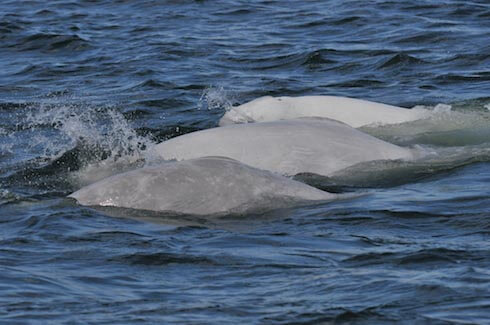[Updated on September 28th]
Once again this year, from June 21 to September 21, the Baie Sainte-Marguerite sector remained off-limits to boating. Only kayaks, canoes and recreational fishing boats were granted special permission to traverse the area and only along the shoreline.
A quiet sanctuary for belugas
This restriction aims to reduce disturbance to St. Lawrence belugas, especially adults accompanied by juveniles, which represent more than 90% of the belugas frequenting this particular sector of the Saguenay, according to monitoring data conducted by Parks Canada.
Since far fewer boats pass through these waters than in the portion of the St. Lawrence Estuary that lies within the Marine Park, the Saguenay Fjord constitutes an acoustic refuge for belugas. According to a study undertaken in 2018 by Université du Québec en Outaouais in collaboration with the Group for Research and Education on Marine Mammals(GREMM), more than half of all St. Lawrence belugas frequent the Saguenay Fjord. If only females are considered, this proportion rises to two-thirds.
As belugas hunt and find their way by means of echolocation and sound is an essential part of their communication, high noise levels can be particularly detrimental to this species. Hence the importance of protecting their remaining acoustic refuges and monitoring the noise levels in these waters.
In this context, Ocean Wise researcher Valeria Vergara and her team examined acoustic levels recorded in Baie Sainte-Marguerite in 2017 and 2018, i.e. before and after the summer closure went into effect. The results are surprising. In fact, recorded noise levels do not show significant differences before and after the regulations were implemented, which may be attributable to the site’s topography. The Saguenay is quite narrow, and sound travels particularly well in water (five times faster than in air!), which probably explains why the noise levels recorded in the bay are roughly the same regardless of whether boats pass through the bay itself or adjacent to it, the researcher believes.
Does that mean that closing St. Marguerite’s bay is useless? According to Parks Canada, it is estimated that “only long-term monitoring of underwater noise in the sector will be able to highlight how this regulation benefits its soundscape.”
The organization reminds that “even if the regulation was put in place in 2018, increased patrolling and sensibilization efforts had already begun in 2017. The biggest behaviour change by boaters in the sector was detected between 2016 and 2017.”
Not only noise
The simple fact that boats – however quiet they may be – are in the presence of belugas represents a significant disturbance, and therefore a potential source of stress. Thus, even if the difference in noise levels between 2017 and 2018 doesn’t seem significant, the disturbance caused by the presence of boats in the area would be eradicated in this area, given, of course, that the ban on navigation is respected.
Additionally, the complete closure of Baie Sainte-Marguerite to boating is not the only measure in place in the sector to mitigate disturbance to belugas. Idling in the area adjacent to the bay is prohibited, and it is strongly recommended to travel at speeds of between five and ten knots in order to reduce the noise intensity produced by moving craft. In fact, the slower a boat travels, the less noise it makes. According to a number of researchers, including Valeria Vergara, compliance with this measure would help considerably reduce noise-related disturbance experienced by belugas. She and her team will be in the field this summer to collect new acoustic data.
Fewer and fewer offenders
The annual temporary exclusion from St. Marguerite’s bay seems to be more and more respected. According to data collected by Parks Canada observers, the amount of time recreational boaters spent in the bay was reduced by half since the implementation of the regulation, going from 12% to 5,8%. In 2016, which marks the beginning of the first sensibilization efforts on the issue, recreational boats were present for only 42% of the time in the closed zone.
The use of the corridor by kayaks, canoes, and fishermen boats is also more respected, which contributes to reducing the amounts of incidental encounters with belugas and, at the same time, risks of disturbance. Analyses are in motion to assess the level of compliance to speed recommendations in the sector facing the bay. Here’s to hoping the numbers will improve once again this year!






